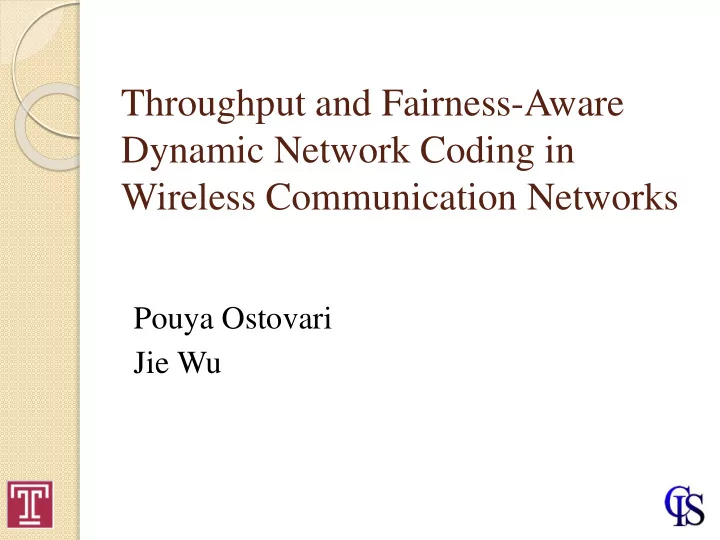

Throughput and Fairness-Aware Dynamic Network Coding in Wireless Communication Networks Pouya Ostovari Jie Wu
Agenda Introduction Motivation and setting Proposed methods ◦ Dynamic network coding ◦ Fair dynamic network coding Simulation results Conclusion 2
Network Coding in Wired Networks Bottleneck problem Without coding With coding
Network Coding in Wireless Networks No coding ◦ 4 transmissions Coding ◦ 3 transmissions Inter-flow coding ◦ Increases the throughput
Network Coding in Wireless Networks Intra-flow coding ◦ Reliability
Setting One source ◦ Broadcasts a set of packets Multiple destinations ◦ Independent erasure channels Equal size time slots ◦ One packet transmission per time slot Objective ◦ Throughput
Introduction (Segment Coding) Segment coding Dynamic coding
Introduction Seen packet ( Sundararajan’08 ) ◦ A node has seen a packet P if it can generate a linear combination of the form P + Q, using the received coded packets in its buffer ◦ 1 ◦ 1 ◦ Seen packets can be removed from the sender’s buffer
Introduction ARQ with network coding (ANC)
Idea Behind and leader nodes Code packets in the range of the first unseen packets by the leader and behind nodes
Multiple Behind and Leader Nodes 2 methods to deal with multiple behind and leader nodes
Dynamic NC without Overhearing All leaders need to transmit a feedback ◦ A receiver that missed the last transmission cannot be a leader node ◦ If the index of the first unseen packet is equal to the largest index included in the received coded packet, then the node is a leader node Behind nodes ◦ If all the behind nodes receive the current transmissions, they do not send any feedback messages 12
Dynamic NC with Overhearing Two feedbacks per time slot Just one leader and one behind node send feedback ◦ Set a back-off time based on the erasure rate of the nodes ◦ The receivers listen to the channel ◦ Leader node finishes its back-off time Send feedback if has not overheard feedback from the other leaders 13
Dynamic NC with Overhearing Two feedbacks per time slot Just one leader and one behind node send feedback ◦ The behind nodes that have received the last transmissions do not need to transmit a feedback ◦ Only one of the nodes that was a behind node in the previous slot, and missed the current transmission should send a feedback 14
Throughput In ANC each transmission has innovative information for all of the nodes ◦ Achieves the maximum throughput ◦ Proof The same approach can be used to prove that the DNC is throughput optimal 15
Fair Dynamic NC Unfairness of ANC and DNC ◦ The nodes with low error rates receive more coded packets than the other nodes, and become the leaders ◦ The nodes with higher error rates might not be able to decode the packet for a long time 16
Fair Dynamic NC A trade-off between fairness and throughput ◦ w : fairness factor ◦ L : number of leaders ◦ m : number of users If x>0, the sender adds a new packet to the coded packet 17
Simulations (Definitions) Decoding delay unfairness Decoding delay fairness Decoding unfairnes 18
Simulations ANC: ARQ with NC DNC: Dynamic network coding without overhearing DNC-OH: Dynamic network coding with overhearing 19
Simulations (Decoding Fairness) ANC: ARQ with NC FDNC: Fain dynamic network coding MW: Moving window 20
Simulations (Delay Fairness) 21
Simulations (Throughput) 22
Simulations (Decodable Packets) 23
Summary Dynamic coding increases the throughput of network coding ◦ Too many feedback messages We propose the DNC and DNC-OH methods to reduce the number of feedbacks We propose the FDNC method to provide decoding and decoding delay fairness 24
Questions 25
Recommend
More recommend